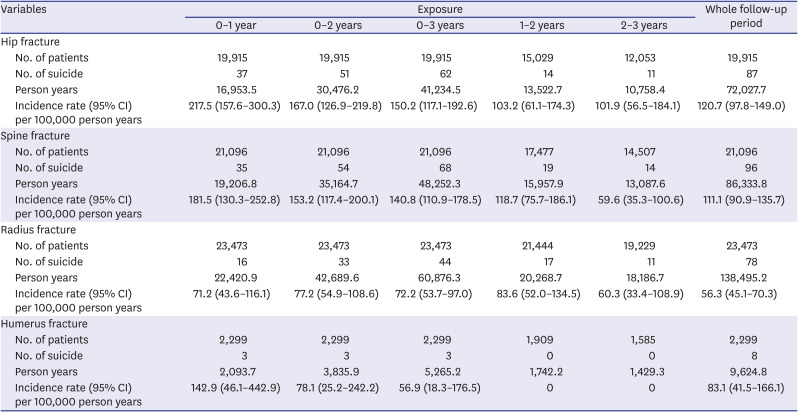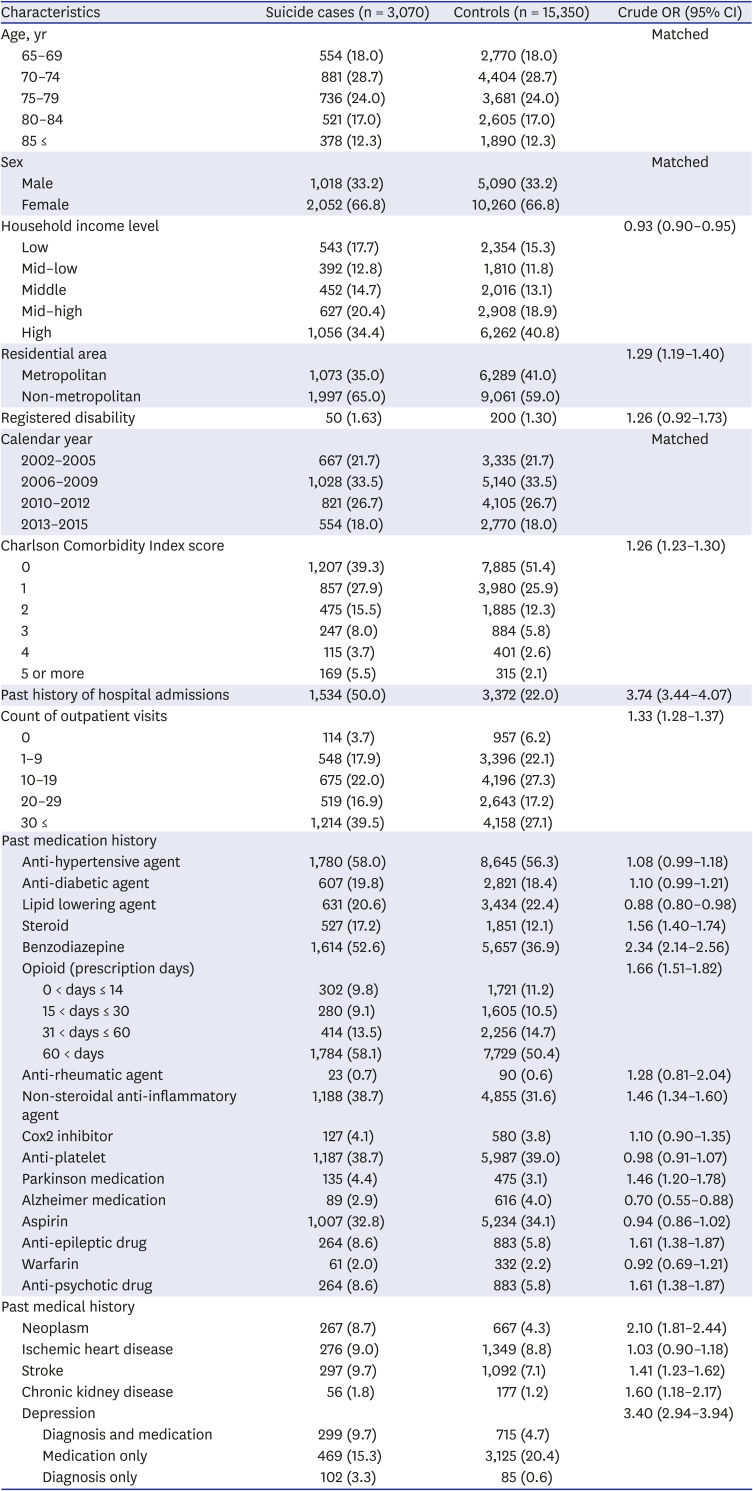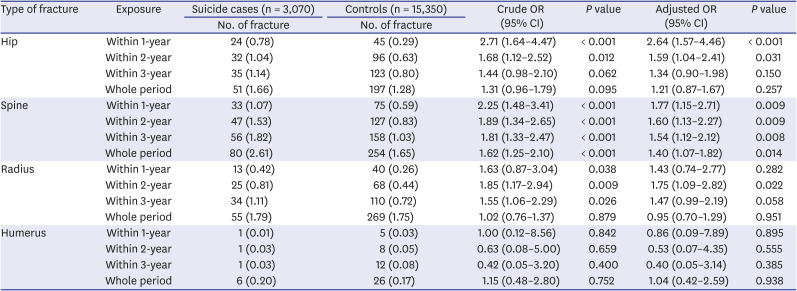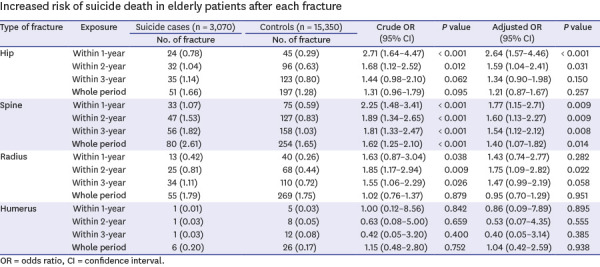1. Ha YC, Kim TY, Lee A, Lee YK, Kim HY, Kim JH, et al. Current trends and future projections of hip fracture in South Korea using nationwide claims data. Osteoporos Int. 2016; 27(8):2603–2609. PMID:
27112763.

2. Major G, Ling R, Searles A, Niddrie F, Kelly A, Holliday E, et al. The costs of confronting osteoporosis: cost study of an Australian fracture liaison service. JBMR Plus. 2018; 3(1):56–63. PMID:
30680364.

3. Ikpeze TC, Smith HC, Lee DJ, Elfar JC. Distal radius fracture outcomes and rehabilitation. Geriatr Orthop Surg Rehabil. 2016; 7(4):202–205. PMID:
27847680.

4. Cha YH, Lee YK, Koo KH, Wi C, Lee KH. Difference in mortality rate by type of anticoagulant in elderly patients with cardiovascular disease after hip fractures. Clin Orthop Surg. 2019; 11(1):15–20. PMID:
30838103.

5. Newman M, Minns Lowe C, Barker K. Spinal orthoses for vertebral osteoporosis and osteoporotic vertebral fracture: a systematic review. Arch Phys Med Rehabil. 2016; 97(6):1013–1025. PMID:
26615791.

6. Sarmiento A, Zagorski JB, Zych GA, Latta LL, Capps CA. Functional bracing for the treatment of fractures of the humeral diaphysis. J Bone Joint Surg Am. 2000; 82(4):478–486. PMID:
10761938.

7. Mulders MA, Detering R, Rikli DA, Rosenwasser MP, Goslings JC, Schep NW. Association between radiological and patient-reported outcome in adults with a displaced distal radius fracture: a systematic review and meta-analysis. J Hand Surg Am. 2018; 43(8):710–719.e5. PMID:
29908929.

8. Wu J, Qu Y, Wang K, Chen Y. Healthcare Resource utilization and direct medical costs for patients with osteoporotic fractures in China. Value Health Reg Issues. 2019; 18:106–111. PMID:
30909083.

9. Jang SY, Yang DS, Cha YH, Yoo HJ, Kim KJ, Choy WS. Suicide in elderly patients with hip fracture: a South Korean nationwide cohort study. J Bone Joint Surg Am. 2020; 102(12):1059–1065. PMID:
32310843.
10. Jang SY, Cha Y, Kwak JH, Kim KJ, Kim HY, Choy WS. what is the difference in the risk of suicide death between spine fracture in patients older than 65 years and matched controls? A large-database study from South Korea. Clin Orthop Relat Res. 2020; 478(11):2422–2430. PMID:
33093384.

11. Cheol Seong S, Kim YY, Khang YH, Heon Park J, Kang HJ, Lee H, et al. Data resource profile: the national health information database of the National Health Insurance Service in South Korea. Int J Epidemiol. 2017; 46(3):799–800. PMID:
27794523.

12. Kim YI, Kim YY, Yoon JL, Won CW, Ha S, Cho KD, et al. Cohort profile: National Health Insurance Service-Senior (NHIS-Senior) cohort in Korea. BMJ Open. 2019; 9(7):e024344.

13. Lee J, Lee JS, Park SH, Shin SA, Kim K. Cohort profile: the National Health Insurance Service-National Sample Cohort (NHIS-NSC), South Korea. Int J Epidemiol. 2017; 46(2):e15. PMID:
26822938.

14. Park C, Jang S, Jang S, Ha YC, Lee YK, Yoon HK, et al. Identification and validation of osteoporotic hip fracture using the national health insurance database. J Korean Hip Soc. 2010; 22(4):305–311.

15. Lee YK, Ha YC, Choi HJ, Jang S, Park C, Lim YT, et al. Bisphosphonate use and subsequent hip fracture in South Korea. Osteoporos Int. 2013; 24(11):2887–2892. PMID:
23681088.

16. Jang SY, Cha YH, Mun YS, Kim SH, Kim HY, Choy WS. Acute cholecystitis in elderly patients after hip fracture: a nationwide cohort study. J Korean Med Sci. 2019; 34(5):e36. PMID:
30718989.

17. Choi SH, Kim DY, Koo JW, Lee SG, Jeong SY, Kang CN. Incidence and management trends of osteoporotic vertebral compression fractures in South Korea: a nationwide population-based study. Asian Spine J. 2020; 14(2):220–228. PMID:
31668050.

18. Jung HS, Nho JH, Ha YC, Jang S, Kim HY, Yoo JI, et al. Incidence of osteoporotic refractures following proximal humerus fractures in adults aged 50 years and older in Korea. J Bone Metab. 2019; 26(2):105–111. PMID:
31223607.

19. Kim DG, Seo GW, Nam HW. Trends in the diagnosis of osteoporosis in patients with distal radius fractures based on a national claims database. J Bone Metab. 2019; 26(4):247–252. PMID:
31832390.

20. Quan H, Sundararajan V, Halfon P, Fong A, Burnand B, Luthi JC, et al. Coding algorithms for defining comorbidities in ICD-9-CM and ICD-10 administrative data. Med Care. 2005; 43(11):1130–1139. PMID:
16224307.

21. Frénisy MC, Plassard C. Suicide in the elderly. Soins. 2017; 62(814):39–41.
22. De Leo D. Suicidal behavior in late life: reasons and reactions to it. Int Psychogeriatr. 2019; 31(11):1531–1533. PMID:
31787136.

23. Erlangsen A, Stenager E, Conwell Y. Physical diseases as predictors of suicide in older adults: a nationwide, register-based cohort study. Soc Psychiatry Psychiatr Epidemiol. 2015; 50(9):1427–1439. PMID:
25835959.

24. Arafat SM, Khan ST. Suicide prevention in Bangladesh: only decriminalization would not be beneficial in an expected fashion. Asian J Psychiatr. 2019; 42:22–23. PMID:
30947091.

25. Lee SU, Park JI, Lee S, Oh IH, Choi JM, Oh CM. Changing trends in suicide rates in South Korea from 1993 to 2016: a descriptive study. BMJ Open. 2018; 8(9):e023144.

26. Rahouma M, Kamel M, Abouarab A, Eldessouki I, Nasar A, Harrison S, et al. Lung cancer patients have the highest malignancy-associated suicide rate in USA: a population-based analysis. Ecancermedicalscience. 2018; 12:859. PMID:
30174721.

27. Kim HY, Ha YC, Kim TY, Cho H, Lee YK, Baek JY, et al. Healthcare costs of osteoporotic fracture in Korea: information from the National Health Insurance Claims Database, 2008–2011. J Bone Metab. 2017; 24(2):125–133. PMID:
28642857.

28. Gómez-Álvarez J, González-Escobar S, Gil-Garay E. Clinical assessment of patients with isolated hip fractures associated with an upper limb fracture. Rev Esp Cir Ortop Traumatol (Engl Ed). 2018; 62(3):222–227. PMID:
29196226.

29. Levin LS, Rozell JC, Pulos N. Distal radius fractures in the elderly. J Am Acad Orthop Surg. 2017; 25(3):179–187. PMID:
28199291.

30. Dewan N, MacDermid JC, Grewal R, Beattie K. Risk factors predicting subsequent falls and osteoporotic fractures at 4 years after distal radius fracture-a prospective cohort study. Arch Osteoporos. 2018; 13(1):32. PMID:
29558002.








 PDF
PDF Citation
Citation Print
Print




 XML Download
XML Download